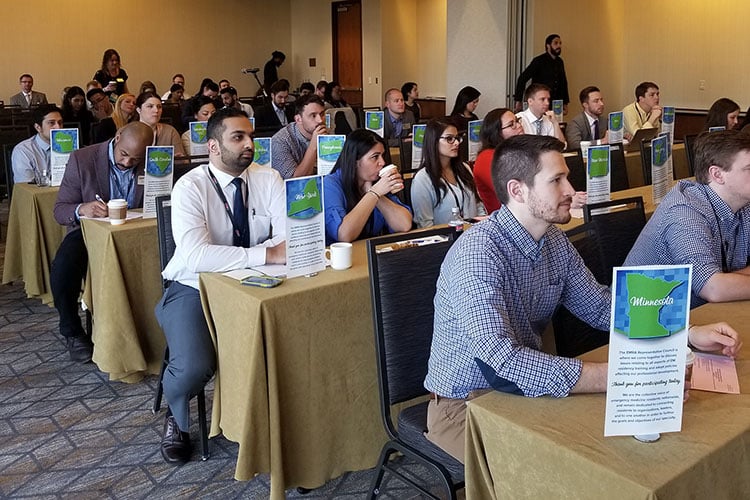Fall 2021 AMA Updates: Emergency Medicine’s Role in Reducing Maternal Mortality
Alysa Edwards, MSIV - University of Colorado School of Medicine
EMRA MSC AMA MSS Delegate, 2021-2022
AMA November 2021 Special Meeting Recap
During the November Special Meeting of the American Medical Association (AMA), physicians, residents, and students from around the country gathered virtually to help set the AMA’s legislative and advocacy agenda. Discussion ranged from increasing rural physician practice to countering COVID-19 misinformation. The Medical Student Section (MSS), often referred to as the “conscience of the AMA,” successfully passed several resolutions both within the MSS as well as the House of Delegates. At the section level, students voted to support efforts surrounding universal childcare and preschool, medicare coverage of dental, vision, and hearing services, as well as protections for medical students. Within the House, medical students advocated for enhanced harm reduction strategies for people who use drugs, additional policing reform measures, disaggregation of racial data, and preservation of medical student access to abortion training. Unfortunately, several medical student items, including resolutions on climate change, reparations, and sexual assault, were not considered for discussion after an internal and hotly debated committee determined such items were not a priority for the special meeting. The role of this committee will be considered at future meetings.
Emergency Medicine & Maternal Mortality
Following a joint report from the AMA Councils on Medical Service (CMS) and Science and Public Health (CSAPH), the AMA also moved to enact a sweeping plan to address pregnancy-related care inequities and maternal mortality [1]. Maternal mortality has worsened over the past quarter-century with 700-900 pregnancy-related deaths occurring per year, two-thirds of which are preventable [2-3]. Although the cause of maternal mortality is multifactorial, it is strongly associated with race; black women are at higher risk regardless of income, education, or geographical location [4-5]. Elevated risks also exist for Native American and some Asian and Latinx populations [6]. Although prenatal and postpartum care can improve outcomes for child-bearing patients, prenatal care initiation is lowest for Black, American Indian/Alaskan, and Native Hawaiian/other Pacific Island patients [7]. These disparities likely reflect social determinants of health, including access to care issues and the effects of structural racism and implicit bias [4].
Access to pregnancy-related care is challenged by patient insurance status. While Medicaid expansion is associated with reductions in maternal mortality as well as reductions in Black-White disparities in adverse birth outcomes, approximately 12% of new mothers remained uninsured between 2016-2018 [6,8,9]. Even pregnant patients insured by Medicaid or CHIP due to pregnancy often lose pregnancy-related coverage 60 days postpartum [10]. Patients in states without Medicaid expansion may fall into a “coverage gap” wherein their incomes are too high for Medicaid but too low to qualify for subsidized Affordable Care Act Marketplace coverage [9]. Other patients are ineligible for Medicaid, CHIP, and/or Marketplace coverage due to immigration status [9].
While emergency medicine physicians are not intended to be the primary providers for pregnant patients, EM physicians have a legal, ethical, and professional responsibility to advocate and care for this population. Patients insured by Medicaid and those without insurance are three to fives times more likely to visit the emergency department during pregnancy and are less likely to initiate prenatal care or have a postpartum checkup [11-13]. Undocumented patients also face barriers to prenatal care with patients and babies who received no prenatal care experiencing worse health outcomes and increased overall costs [14]. Caring for pregnant patients in the emergency department, particularly uninsured, underinsured, or undocumented patients, may require new considerations in how care is delivered and how patients are referred to specialists [15]. Beyond the physical walls of the department, providers may also care for pregnant patients by supporting initiatives to expand access to quality care sensitive to the needs of the population served.
The CMS/CSAPH Joint Report, in conjunction with a related medical student resolution, takes steps to address many of these issues by acknowledging the impact of structural racism and bias, supporting expanded payment structures, and promoting patient-centered standards and education to address existing inequalities in care delivery. During the Special Meeting, several EM physicians and residents within the AMA recognized the importance of these initiatives in not only reducing emergency care visits and costs, but also improving pregnancy outcomes for our patients. The EM community should continue to look for ways to reduce maternal mortality through the refinement of pregnancy care delivered in the ED as well as advocacy work on the local and national levels.
References
- Council on Medical Service & Council on Science and Public Health. Reducing Inequities and Improving Access to Insurance for Maternal Health Care. 2021. https://www.ama-assn.org/system/files/n21-cms-csaph-01.pdf
- Petersen EE, Davis NL, Goodman D, et al. Vital Signs: Pregnancy-Related Deaths, United States, 2011–2015, and Strategies for Prevention, 13 States, 2013–2017. MMWR Morb Mortal Wkly Rep 2019. 2019;68:423–429. doi:http://dx.doi.org/10.15585/mmwr.mm6818e1
- Eckert E. Preserving the Momentum to Extend Postpartum Medicaid Coverage. Womens Health Issues. Nov-Dec 2020;30(6):401-404. doi:10.1016/j.whi.2020.07.006
- Centers for Disease Control and Prevention. Pregnancy Mortality Surveillance System. Accessed December 10, 2021. https://www.cdc.gov/reproductivehealth/maternal-mortality/pregnancy-mortality-surveillance-system.htm
- McLemore MR, D’Efilippo V.. To Prevent Women from Dying in Childbirth, First Stop Blaming Them. Scientific American. May 1, 2019 2019;
- Howell E, Brown, H, Brumley, J, Bryant, AS, Caughey, AB, et al. . Reduction of Peripartum Racial and Ethnic Disparities: A Conceptual Framework and Maternal Safety Consensus Bundle. Obstetrics & Gynecology. 2018;131(5)
- Howell E. Reducing Disparities in Severe Maternal Morbidity and Mortality. Clin Obstet Gynecol. 2018;61(2):387-399. doi:10.1097/GRF.0000000000000349
- Johnston EM, McMorrow S, Alvarez Caraveo C, Dubay L. Post-ACA, More Than One-Third Of Women With Prenatal Medicaid Remained Uninsured Before Or After Pregnancy. Health Affairs. 2021/04/01 2021;40(4):571-578. doi:10.1377/hlthaff.2020.01678
- Johnston EM HJ, McMorrow S, Kenney GM, Thomas TW, Pan CW, Wang R. Closing Postpartum Coverage Gaps and Improving Continuity and Affordability of Care through a Postpartum Medicaid/CHIP Extension. Urban Institute. January 2021 2021;
- MACPAC. Medicaid’s Role in Financing Maternity Care 2020. https://www.macpac.gov/wp-content/uploads/2020/01/Medicaid%E2%80%99s-Role-in-Financing-Maternity-Care.pdf
- Taylor YJ, Liu T-L, Howell EA. Insurance Differences in Preventive Care Use and Adverse Birth Outcomes Among Pregnant Women in a Medicaid Nonexpansion State: A Retrospective Cohort Study. J Womens Health (Larchmt). 2020;29(1):29-37. doi:10.1089/jwh.2019.7658
- Kilfoyle KA, Vrees R, Raker CA, Matteson KA. Nonurgent and urgent emergency department use during pregnancy: an observational study. Am J Obstet Gynecol. 2017;216(2):181.e1-181.e7. doi:10.1016/j.ajog.2016.10.013
- Malik S, Kothari C, MacCallum C, Liepman M, Tareen S, Rhodes KV. Emergency Department Use in the Perinatal Period: An Opportunity for Early Intervention. Annals of Emergency Medicine. 2017/12/01/ 2017;70(6):835-839. doi:https://doi.org/10.1016/j.annemergmed.2017.06.020
- Lu MC, Lin YG, Prietto NM, Garite TJ. Elimination of public funding of prenatal care for undocumented immigrants in California: A cost/benefit analysis. Am J Obstet Gynecol. 2000/01/01/ 2000;182(1):233-239. doi:https://doi.org/10.1016/S0002-9378(00)70518-7
- Brenner JM, Blutinger E, Ricke B, Vearrier L, Kluesner NH, Moskop JC. Ethical issues in the access to emergency care for undocumented immigrants. J Am Coll Emerg Physicians Open. 2021;2(3):e12461-e12461. doi:10.1002/emp2.12461
Related Content

Nov 02, 2022
Critical Care Alert: The CT FIRST Cohort Study
While it didn’t improve survival to hospital discharge or neurologic recovery vs the current standard of care, the sudden death CT (SDCT) protocol significantly improved the time and diagnostic ability to determine the cause of out-of-hospital cardiac arrest. Consider SDCT as a way to focus appropriate care and identify time-critical diagnoses for the critically ill post-cardiac arrest patient with an unclear cause of arrest.

May 26, 2023
PD Interview Saks at Crozer Chester
In the latest installment of our PD Q&A series, we are highlighting the Crozer Chester Medical Center Emergency Medicine Residency program. We spoke with the current PD Dr. Mark Saks, MD, about what makes his program unique and what he looks for in potential residents.





